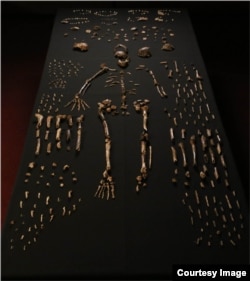A group of scientists announced Thursday what they say is the discovery of remains from an early ancestor of human beings.
Bones from the species were found two years ago inside a cave at a United Nations World Heritage Site, near Johannesburg, South Africa. The South African government has named the area the “Cradle of Humankind” because of its rich collection of ancient human-like remains.
The scientists are calling the new species, ‘Homo naledi’. The word naledi means “star” in South Africa’s Sesotho language.
The scientists reported that about 1,500 bones have been recovered from the cave. They said the bones come from at least 15 individuals. The team reported its findings in the journal eLIFE.
Lead scientist Lee Berger works at the University of Witwatersrand. He said the discovery “was right under our nose in the most explored valley of the continent of Africa.” Mr. Berger spoke to reporters Thursday in Johannesburg.
“This is a great moment for us. It is a moment that was perhaps two years in the making. For some of you who may follow our adventures since November of 2013. But in fact, it is 90 years in the making: 90 years of exploration here in South Africa for human origins.”
The scientists said the newly discovered species ‘Homo naledi’ probably stood up straight when walking. They said a normal adult stood about 1.5 meters tall and weighed about 45 kilograms.
The researchers described the hands and feet of the new species as human-like. But they said the ribs, shoulders and pelvis were closer to other early ancestors than to those of modern humans.
The Associated Press reported that Mr. Berger said his team is not claiming that Homo naledi was a direct ancestor of modern-day people.
The researchers believe neledi developed between 2.5 million and 2.8 million years ago, but the bones might be younger than that. The team said dating the bones is one of their projects.
Also unclear is why the bones were in a hard-to-reach part of the cave in the first place. Scientists wondered whether others could have placed dead bodies there in a kind of behavior rarely found in early humans.
I’m Jim Tedder.
This report was based on stories from VOA, with additional information from the Associated Press and Reuters. George Grow adapted this story for Learning English. Hai Do was the editor.
______________________________________________________________
Words in This Story
species – n. a group of things or people that belong together or share similar qualities
cradle – n. the place where something begins; a bed for a baby
adventure(s) – n. an exciting or dangerous experience
origins – n. beginnings; the place where something begins or is created






